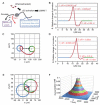In Silico Reconstruction of Sperm Chemotaxis
- PMID: 34502014
- PMCID: PMC8431315
- DOI: 10.3390/ijms22179104
In Silico Reconstruction of Sperm Chemotaxis
Abstract
In echinoderms, sperm swims in random circles and turns in response to a chemoattractant. The chemoattractant evokes transient Ca2+ influx in the sperm flagellum and induces turning behavior. Recently, the molecular mechanisms and biophysical properties of this sperm response have been clarified. Based on these experimental findings, in this study, we reconstructed a sperm model in silico to demonstrate an algorithm for sperm chemotaxis. We also focused on the importance of desensitizing the chemoattractant receptor in long-range chemotaxis because sperm approach distantly located eggs, and they must sense the chemoattractant concentration over a broad range. Using parameters of the sea urchin, simulations showed that a number of sperm could reach the egg from millimeter-order distances with desensitization, indicating that we could organize a functional sperm model, and that desensitization of the receptor is essential for sperm chemotaxis. Then, we compared the model with starfish sperm, which has a different desensitization scheme and analyzed the properties of the model against various disturbances. Our approach can be applied as a novel tool in chemotaxis research.
Keywords: desensitization; fertilization; modeling of cell; sperm chemotaxis.
Conflict of interest statement
The authors declare no conflict of interest.
Figures




Similar articles
-
Ca2+ spikes in the flagellum control chemotactic behavior of sperm.EMBO J. 2005 Aug 3;24(15):2741-52. doi: 10.1038/sj.emboj.7600744. Epub 2005 Jul 7. EMBO J. 2005. PMID: 16001082 Free PMC article.
-
Tuning sperm chemotaxis by calcium burst timing.Dev Biol. 2010 Aug 1;344(1):52-65. doi: 10.1016/j.ydbio.2010.04.013. Epub 2010 May 16. Dev Biol. 2010. PMID: 20435032
-
Sperm chemotaxis is driven by the slope of the chemoattractant concentration field.Elife. 2020 Mar 9;9:e50532. doi: 10.7554/eLife.50532. Elife. 2020. PMID: 32149603 Free PMC article.
-
Tuning sperm chemotaxis.Biochem Soc Trans. 2010 Oct;38(5):1270-4. doi: 10.1042/BST0381270. Biochem Soc Trans. 2010. PMID: 20863297 Review.
-
Sperm chemotaxis and regulation of flagellar movement by Ca2+.Mol Hum Reprod. 2011 Aug;17(8):457-65. doi: 10.1093/molehr/gar041. Epub 2011 May 24. Mol Hum Reprod. 2011. PMID: 21610215 Review.
References
-
- Coll J.C., Bowden B.F., Meehan G.V., Konig G.M., Carroll A.R., Tapiolas D.M., Alino P.M., Heaton A., De Nys R., Leone P.A., et al. Chemical aspects of mass spawning in corals. I. Sperm-attractant molecules in the eggs of the scleractinian coral Montipora digitata. Mar. Biol. 1994;118:177–182. doi: 10.1007/BF00349783. - DOI
MeSH terms
Grants and funding
LinkOut - more resources
Full Text Sources
Miscellaneous

